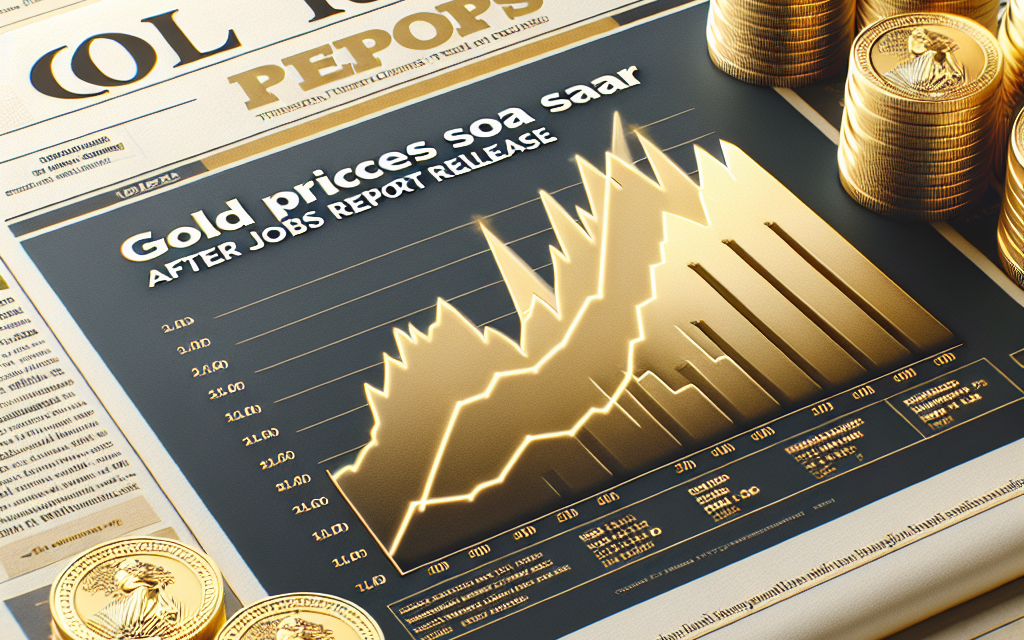“Gold Prices Surge as Jobs Report Sparks Market Reactions!”
Introduction
Gold prices surged following the release of the latest jobs report, reflecting investor concerns over economic stability and inflation. The report indicated weaker-than-expected job growth, prompting market participants to seek the safety of gold as a hedge against potential economic downturns. This spike in gold prices underscores the metal’s role as a safe-haven asset during times of uncertainty, as investors react to shifting economic indicators and the implications for monetary policy.
Gold Prices Surge Following Strong Jobs Report
In recent weeks, the financial markets have experienced significant fluctuations, particularly in the precious metals sector. A notable event that has contributed to this volatility is the release of the latest jobs report, which has had a profound impact on gold prices. Following the announcement, gold prices surged, reflecting investor sentiment and market dynamics in response to the economic indicators presented.
The jobs report, which is a critical barometer of economic health, revealed stronger-than-expected employment figures. This unexpected growth in job creation has led many analysts to reassess their forecasts for the economy. While a robust jobs report typically signals a strengthening economy, it also raises concerns about inflation and interest rates. As a result, investors often turn to gold as a safe haven during times of uncertainty. The immediate reaction to the report was a notable increase in gold prices, as market participants sought to hedge against potential inflationary pressures that could arise from a tightening labor market.
Moreover, the surge in gold prices can be attributed to the broader context of monetary policy. Central banks, particularly the Federal Reserve, have been closely monitoring employment data to guide their decisions on interest rates. A strong jobs report could prompt the Fed to consider tightening monetary policy sooner than anticipated, which historically has led to increased volatility in financial markets. In this environment, gold is often viewed as a hedge against currency devaluation and rising interest rates. Consequently, the immediate aftermath of the jobs report saw a significant uptick in demand for gold, pushing prices higher.
In addition to the immediate market reactions, the long-term implications of the jobs report cannot be overlooked. Investors are increasingly aware that sustained job growth could lead to wage increases, which in turn may fuel inflation. As inflation erodes purchasing power, gold often becomes an attractive asset for those looking to preserve wealth. This perspective has been reinforced by the recent trends in consumer prices, which have shown signs of upward pressure. As such, the combination of a strong jobs report and inflationary concerns has created a perfect storm for gold prices to rise.
Furthermore, geopolitical factors also play a crucial role in shaping investor behavior. In times of global uncertainty, such as geopolitical tensions or economic instability in major markets, gold tends to benefit from increased demand. The recent jobs report, while positive, has not eliminated concerns about potential economic headwinds, including supply chain disruptions and geopolitical conflicts. As investors weigh these risks, gold remains a favored asset class, further contributing to its price surge.
In conclusion, the recent spike in gold prices following the release of the jobs report underscores the intricate relationship between employment data, inflation expectations, and investor sentiment. As the economy continues to evolve, market participants will remain vigilant, closely monitoring economic indicators and central bank policies. The interplay of these factors will undoubtedly influence the trajectory of gold prices in the coming months. As such, investors should stay informed and consider the implications of economic data releases on their investment strategies, particularly in the realm of precious metals. The current environment serves as a reminder of gold’s enduring appeal as a hedge against uncertainty and a store of value in an ever-changing economic landscape.
Impact of Employment Data on Gold Market Trends
The relationship between employment data and gold prices is a critical aspect of financial markets, as fluctuations in job statistics can significantly influence investor sentiment and market dynamics. When employment reports are released, they often serve as a barometer for the overall health of the economy. A robust jobs report typically indicates economic strength, which can lead to increased confidence in equities and a subsequent decline in gold prices. Conversely, a weaker jobs report can trigger fears of economic slowdown, prompting investors to seek the safety of gold, thereby driving prices upward.
In recent weeks, the release of a particularly strong jobs report has had a profound impact on the gold market. Initially, one might expect that positive employment figures would lead to a decrease in gold prices, as investors shift their focus to riskier assets. However, the nuances of market psychology and the broader economic context can lead to different outcomes. For instance, while the jobs report may suggest a thriving economy, it can also raise concerns about inflation and the potential for aggressive monetary policy adjustments by central banks. In this scenario, gold, often viewed as a hedge against inflation, becomes increasingly attractive to investors.
Moreover, the interplay between interest rates and gold prices cannot be overlooked. When employment data indicates a strong labor market, central banks may feel compelled to raise interest rates to curb inflationary pressures. Higher interest rates typically strengthen the currency, making gold, which is priced in dollars, more expensive for foreign investors. This dynamic can lead to a decrease in demand for gold, exerting downward pressure on its price. However, if the market perceives that the central bank’s actions may not be sufficient to combat inflation, or if there are concerns about economic stability, gold can still rally as a safe-haven asset.
Additionally, geopolitical factors and global economic conditions play a significant role in shaping the gold market. For instance, if a strong jobs report coincides with rising tensions in international relations or economic uncertainty in other regions, investors may flock to gold as a protective measure. This behavior underscores the multifaceted nature of the gold market, where various influences converge to determine price movements.
Furthermore, the psychological aspect of trading cannot be underestimated. Market participants often react not just to the data itself but also to the narratives surrounding it. A strong jobs report may lead to speculation about future economic conditions, prompting investors to reassess their portfolios. If the prevailing sentiment shifts towards caution, even in the face of positive employment data, gold may benefit from increased buying interest as a safeguard against potential downturns.
In conclusion, the impact of employment data on gold market trends is complex and multifaceted. While strong job figures can initially suggest a thriving economy, they can also raise concerns about inflation and interest rates, leading to increased demand for gold as a safe-haven asset. Additionally, geopolitical factors and market psychology further complicate this relationship, illustrating that gold prices are influenced by a myriad of factors beyond mere employment statistics. As such, investors must remain vigilant and consider the broader economic landscape when interpreting the implications of employment data on gold prices.
Analyzing the Correlation Between Jobs Reports and Gold Prices
The relationship between jobs reports and gold prices is a complex interplay that reflects broader economic conditions and investor sentiment. When a jobs report is released, it often serves as a barometer for the health of the economy, influencing various financial markets, including commodities like gold. Typically, a strong jobs report, indicating robust employment growth, can lead to a rise in consumer confidence and spending. This, in turn, may prompt the Federal Reserve to consider tightening monetary policy, which often results in a stronger U.S. dollar. Consequently, as the dollar strengthens, gold prices tend to decline, as gold is priced in dollars and becomes more expensive for foreign investors.
Conversely, a weak jobs report can have the opposite effect. When employment figures fall short of expectations, it raises concerns about economic growth and can lead to speculation that the Federal Reserve may adopt a more accommodative monetary policy stance. In such scenarios, the dollar may weaken, making gold more attractive as a hedge against inflation and currency devaluation. As a result, gold prices often rise in response to disappointing employment data, as investors flock to the perceived safety of precious metals during times of economic uncertainty.
Moreover, the volatility in gold prices following jobs reports can also be attributed to market psychology. Investors often react not only to the data itself but also to the implications of that data for future monetary policy. For instance, if a jobs report indicates a slowdown in job creation, market participants may anticipate that the Federal Reserve will delay interest rate hikes or even consider rate cuts. This expectation can lead to increased demand for gold, as lower interest rates diminish the opportunity cost of holding non-yielding assets like gold.
Additionally, the timing of jobs reports can coincide with other economic indicators, further complicating the relationship between employment data and gold prices. For example, if a jobs report is released alongside inflation data that shows rising prices, the combination can create a perfect storm for gold. In such cases, the dual concerns of economic stagnation and inflation can drive investors toward gold as a safe haven, resulting in significant price increases.
It is also important to consider the global context when analyzing the correlation between jobs reports and gold prices. Economic conditions in other countries, geopolitical tensions, and changes in global demand for gold can all influence how U.S. jobs reports affect gold prices. For instance, if a jobs report indicates strong employment growth in the U.S. while other major economies are struggling, the dollar may strengthen, but gold could still see upward pressure if global uncertainties persist.
In summary, the correlation between jobs reports and gold prices is multifaceted, shaped by economic indicators, market psychology, and global dynamics. While strong employment data typically leads to a decline in gold prices due to a stronger dollar and expectations of tighter monetary policy, weak jobs reports can trigger a surge in gold prices as investors seek refuge from economic uncertainty. Understanding this relationship is crucial for investors looking to navigate the complexities of the financial markets, particularly in times of economic flux. As such, the release of jobs reports remains a pivotal moment for both the labor market and the precious metals market, underscoring the interconnectedness of economic indicators and asset prices.
Investor Reactions to Rising Gold Prices Post-Jobs Report
In the wake of the recent jobs report, gold prices have experienced a significant surge, prompting a variety of reactions from investors across the financial landscape. The report, which indicated stronger-than-expected job growth, has led many to reassess their investment strategies, particularly in the context of inflationary pressures and economic uncertainty. As gold is traditionally viewed as a safe-haven asset, its rising prices reflect a growing sentiment among investors that they should seek refuge in more stable investments during turbulent economic times.
The immediate reaction to the jobs report was a notable increase in gold prices, which rose sharply as investors sought to hedge against potential volatility in the stock market. This trend is not surprising, as gold often serves as a counterbalance to the fluctuations of equities. When economic indicators suggest instability or when inflation fears loom large, investors typically gravitate towards gold, viewing it as a reliable store of value. Consequently, the spike in gold prices following the jobs report underscores a broader trend of risk aversion among market participants.
Moreover, the jobs report has implications that extend beyond immediate price movements. Investors are now contemplating the potential for future interest rate adjustments by the Federal Reserve. With employment figures indicating robust growth, there is speculation that the central bank may consider tightening monetary policy sooner than previously anticipated. This prospect has led to a complex interplay between gold prices and interest rate expectations. Generally, rising interest rates can exert downward pressure on gold, as higher yields on bonds and other fixed-income investments make them more attractive compared to non-yielding assets like gold. However, in the current environment, the fear of inflation may outweigh these concerns, leading to sustained interest in gold as a hedge.
As investors digest the implications of the jobs report, many are also evaluating their long-term strategies. Some are opting to increase their allocations to gold, viewing it as a prudent move in an uncertain economic climate. Others are taking a more cautious approach, choosing to monitor market conditions closely before making significant changes to their portfolios. This divergence in strategies highlights the complexity of the current investment landscape, where macroeconomic indicators can have far-reaching effects on asset classes.
In addition to individual investor reactions, institutional investors are also recalibrating their strategies in light of the rising gold prices. Many large funds and asset managers are reassessing their exposure to gold, considering it not only as a hedge against inflation but also as a diversification tool in their portfolios. The growing interest from institutional players can further drive up demand for gold, creating a feedback loop that reinforces its status as a safe haven.
In conclusion, the release of the jobs report has catalyzed a notable increase in gold prices, prompting a range of reactions from investors. As they navigate the complexities of the current economic environment, many are turning to gold as a means of safeguarding their investments against potential risks. This shift in sentiment reflects a broader trend of risk aversion, as market participants seek stability amid uncertainty. Ultimately, the interplay between economic indicators, interest rates, and investor behavior will continue to shape the dynamics of the gold market in the months to come.
Historical Patterns: Gold Price Movements After Jobs Reports
Gold prices have long been viewed as a barometer of economic stability and investor sentiment, often reacting sharply to key economic indicators, particularly employment data. Historical patterns reveal a consistent trend where gold prices exhibit notable fluctuations following the release of jobs reports, reflecting the market’s interpretation of economic health and future monetary policy. The relationship between gold prices and employment statistics is multifaceted, influenced by various factors including inflation expectations, interest rates, and overall market confidence.
In the aftermath of a jobs report, particularly one that exceeds expectations, gold prices often experience a decline. This reaction can be attributed to the anticipation of tighter monetary policy, as strong employment figures typically signal a robust economy. When job growth is strong, central banks may feel compelled to raise interest rates to curb inflation, which in turn diminishes the appeal of non-yielding assets like gold. Conversely, when jobs data falls short of projections, gold prices tend to rise. Investors often flock to gold as a safe haven during times of economic uncertainty, seeking to hedge against potential market volatility and currency devaluation.
Moreover, the context surrounding each jobs report plays a crucial role in determining gold price movements. For instance, if a jobs report indicates a significant increase in unemployment or stagnant wage growth, it may lead to concerns about economic stagnation. In such scenarios, gold often becomes an attractive investment, as it is perceived as a hedge against economic downturns. Historical data supports this notion, as periods of economic distress have frequently coincided with surges in gold prices, underscoring the metal’s role as a store of value during turbulent times.
Additionally, the broader economic landscape influences how gold reacts to jobs reports. For example, during periods of high inflation, even a strong jobs report may not deter investors from purchasing gold. In such cases, the fear of rising prices can overshadow the positive employment data, leading to increased demand for gold as a protective asset. This dynamic illustrates the complexity of market reactions, where multiple economic indicators interact to shape investor behavior.
Furthermore, the timing of jobs reports in relation to other economic announcements can amplify their impact on gold prices. For instance, if a jobs report is released shortly before a Federal Reserve meeting, the implications for monetary policy can be particularly pronounced. Investors closely monitor these reports for clues about future interest rate adjustments, and any unexpected data can lead to swift movements in gold prices. Historical trends indicate that gold often rallies in anticipation of dovish monetary policy, as lower interest rates typically enhance the attractiveness of gold.
In conclusion, the historical patterns of gold price movements following jobs reports reveal a complex interplay between economic indicators and investor sentiment. While strong employment data may lead to declines in gold prices due to expectations of tighter monetary policy, weak jobs reports often result in price increases as investors seek refuge in gold amid economic uncertainty. The broader economic context, inflation concerns, and the timing of reports relative to other announcements further complicate these dynamics. As such, understanding these historical patterns is essential for investors looking to navigate the intricate relationship between gold prices and employment data.
Economic Indicators: What the Jobs Report Means for Gold Investors
The release of economic indicators plays a crucial role in shaping market sentiment, and one of the most closely watched reports is the monthly jobs report. This report, which provides insights into employment trends, wage growth, and overall economic health, can significantly influence various asset classes, including gold. Recently, following the release of a particularly strong jobs report, gold prices experienced a notable surge, prompting investors to reassess their strategies in light of the new data.
To understand the implications of the jobs report for gold investors, it is essential to consider the broader economic context. A robust jobs report typically signals a strengthening economy, characterized by increased consumer spending and business investment. However, this positive outlook can also lead to concerns about inflation, especially if wage growth outpaces productivity gains. As wages rise, consumers have more disposable income, which can drive demand for goods and services, potentially leading to higher prices. In such an environment, gold often emerges as a safe-haven asset, as investors seek to protect their wealth from the eroding effects of inflation.
Moreover, the relationship between interest rates and gold prices is another critical factor to consider. When the jobs report indicates a strong labor market, it may prompt central banks, particularly the Federal Reserve, to consider tightening monetary policy. Higher interest rates typically strengthen the currency, making gold, which is priced in dollars, more expensive for foreign investors. Consequently, if the market anticipates that the central bank will raise rates in response to strong employment data, gold prices may initially dip. However, if inflationary pressures persist, the long-term outlook for gold can remain bullish, as investors may flock to the metal as a hedge against inflation.
In addition to inflation and interest rates, geopolitical factors also play a significant role in shaping gold prices. In times of economic uncertainty or geopolitical tensions, gold is often viewed as a safe haven. Therefore, even in the wake of a strong jobs report, if global events create instability, demand for gold may rise. This duality highlights the complexity of the gold market, where various factors can simultaneously influence investor sentiment.
Furthermore, it is essential for gold investors to remain vigilant and responsive to changing economic indicators. The jobs report is just one piece of the puzzle; other data points, such as consumer confidence, manufacturing output, and inflation rates, also provide valuable insights into the overall economic landscape. By analyzing these indicators collectively, investors can make more informed decisions regarding their gold investments.
In conclusion, the recent surge in gold prices following the jobs report underscores the intricate relationship between economic indicators and market dynamics. While a strong jobs report may initially suggest a robust economy, it also raises questions about inflation and interest rates that can impact gold’s appeal. As investors navigate this complex environment, understanding the interplay of these factors will be crucial in determining their investment strategies. Ultimately, gold remains a vital asset for those seeking to hedge against economic uncertainty, and its performance will continue to be influenced by a myriad of economic indicators in the months to come.
Strategies for Investing in Gold Amidst Job Market Fluctuations
In recent months, fluctuations in the job market have significantly influenced various investment strategies, particularly in the realm of precious metals. As gold prices soar following the release of a robust jobs report, investors are increasingly considering gold as a hedge against economic uncertainty. Understanding the dynamics of the job market and its impact on gold prices is essential for developing effective investment strategies.
Firstly, it is crucial to recognize that gold often serves as a safe haven during periods of economic volatility. When job reports indicate strong employment growth, it can lead to increased consumer confidence and spending, which typically strengthens the economy. However, this can also result in concerns about inflation, prompting investors to seek refuge in gold. Therefore, one strategy for investing in gold is to monitor employment data closely. By analyzing trends in job growth and unemployment rates, investors can make informed decisions about when to enter or exit the gold market.
Moreover, diversifying one’s investment portfolio is another prudent strategy. While gold can provide a buffer against economic downturns, it is essential to balance investments across various asset classes. This approach not only mitigates risk but also allows investors to capitalize on different market conditions. For instance, during periods of strong job growth, equities may perform well, while gold may serve as a stabilizing force during downturns. By maintaining a diversified portfolio that includes gold, investors can better navigate the complexities of the job market and its effects on overall economic performance.
In addition to diversification, timing plays a critical role in gold investment strategies. Investors should consider the cyclical nature of the job market and its correlation with gold prices. For example, when job reports indicate a slowdown in hiring or rising unemployment, gold prices may increase as investors flock to safe-haven assets. Conversely, during periods of strong job growth, gold prices may experience downward pressure. By understanding these cycles, investors can strategically time their purchases and sales of gold to maximize returns.
Furthermore, utilizing various investment vehicles can enhance exposure to gold. Traditional methods such as purchasing physical gold or gold coins remain popular; however, investors may also explore exchange-traded funds (ETFs) that track gold prices or invest in gold mining stocks. Each of these options carries its own risk and reward profile, and understanding these nuances is vital for effective investment. For instance, while gold ETFs provide liquidity and ease of trading, mining stocks may offer higher potential returns but come with increased volatility. Therefore, investors should assess their risk tolerance and investment goals when selecting the appropriate vehicle for gold investment.
Lastly, staying informed about global economic indicators and geopolitical events is essential for any investor in gold. Factors such as interest rates, inflation, and international tensions can significantly influence gold prices. By keeping abreast of these developments, investors can better anticipate market movements and adjust their strategies accordingly. In conclusion, as gold prices soar in response to job market fluctuations, employing a multifaceted approach that includes monitoring employment data, diversifying portfolios, timing investments, utilizing various investment vehicles, and staying informed about global events can enhance the effectiveness of gold investment strategies. By adopting these practices, investors can navigate the complexities of the market and position themselves for success in an ever-changing economic landscape.
Q&A
1. **Question:** Why did gold prices soar after the jobs report release?
**Answer:** Gold prices typically rise when economic data, like a jobs report, indicates weaker job growth, leading to concerns about economic stability and prompting investors to seek safe-haven assets.
2. **Question:** What specific jobs report data contributed to the increase in gold prices?
**Answer:** A lower-than-expected increase in non-farm payrolls or a higher unemployment rate can signal economic weakness, driving investors towards gold.
3. **Question:** How do interest rates affect gold prices following a jobs report?
**Answer:** If the jobs report suggests a slowing economy, it may lead to expectations of lower interest rates, which decreases the opportunity cost of holding non-yielding assets like gold, thus boosting its price.
4. **Question:** What role does inflation play in the relationship between jobs reports and gold prices?
**Answer:** If a jobs report indicates rising wages without corresponding job growth, it can raise inflation concerns, leading investors to buy gold as a hedge against inflation.
5. **Question:** How do market sentiments shift after a jobs report that negatively impacts the economy?
**Answer:** Negative economic indicators can create uncertainty, prompting investors to move away from riskier assets and increase their allocation to gold, driving up its price.
6. **Question:** What is the historical trend of gold prices in response to jobs reports?
**Answer:** Historically, gold prices tend to rise following disappointing jobs reports, as they often signal economic challenges and increased demand for safe-haven investments.
7. **Question:** How do geopolitical factors interact with jobs reports to influence gold prices?
**Answer:** Geopolitical tensions can amplify the effects of a weak jobs report, as investors may seek gold as a safe haven amidst both economic uncertainty and global instability.
Conclusion
Gold prices surged following the release of the jobs report, reflecting investor concerns over economic stability and inflation. The report’s weaker-than-expected employment figures prompted a flight to safety, driving demand for gold as a hedge against economic uncertainty. This trend underscores gold’s role as a safe-haven asset in times of market volatility.





